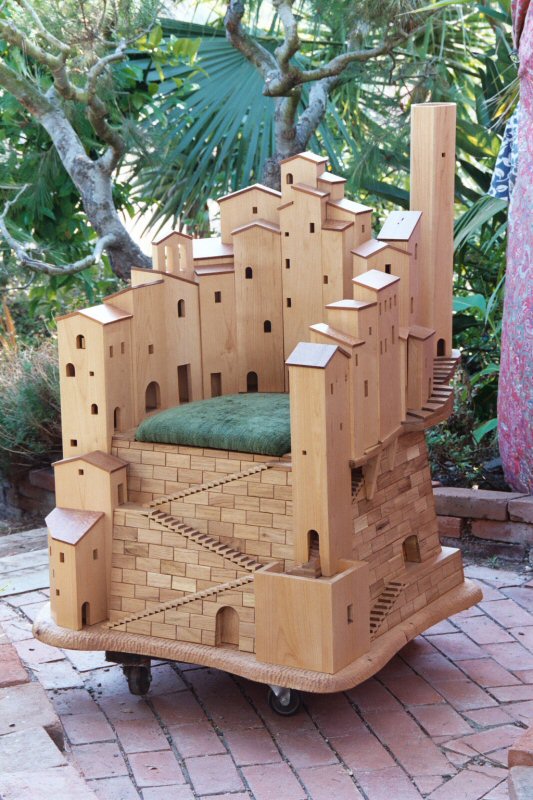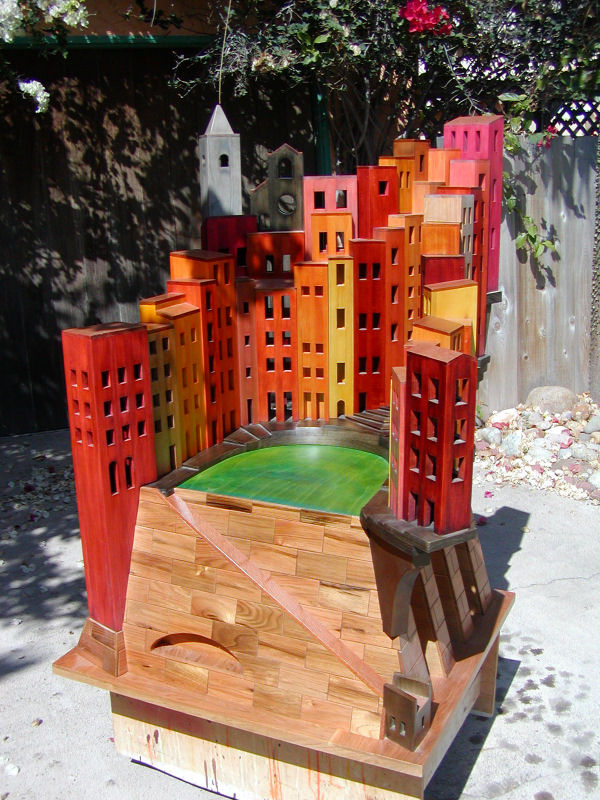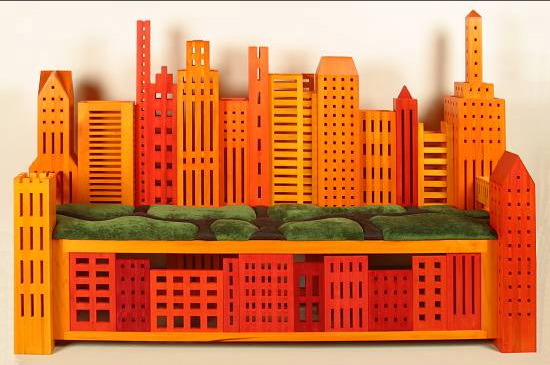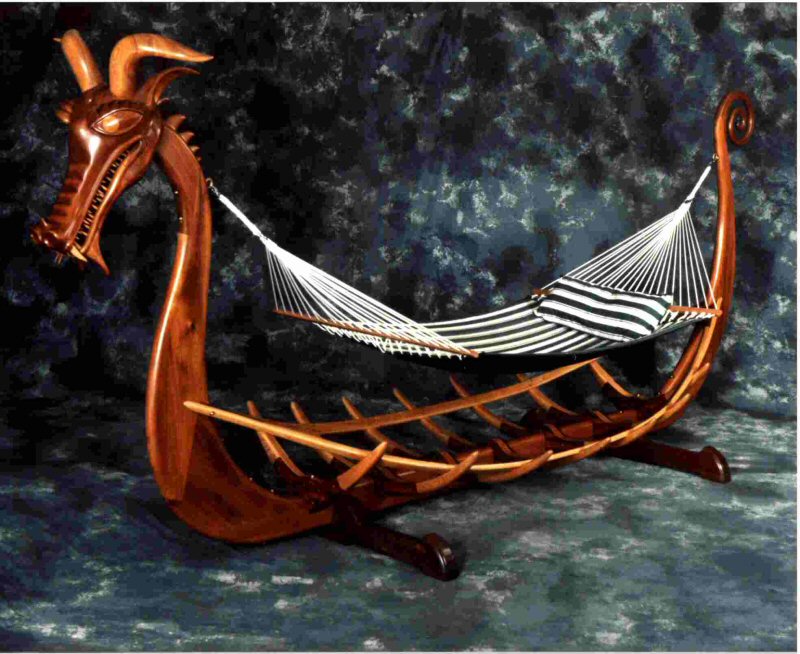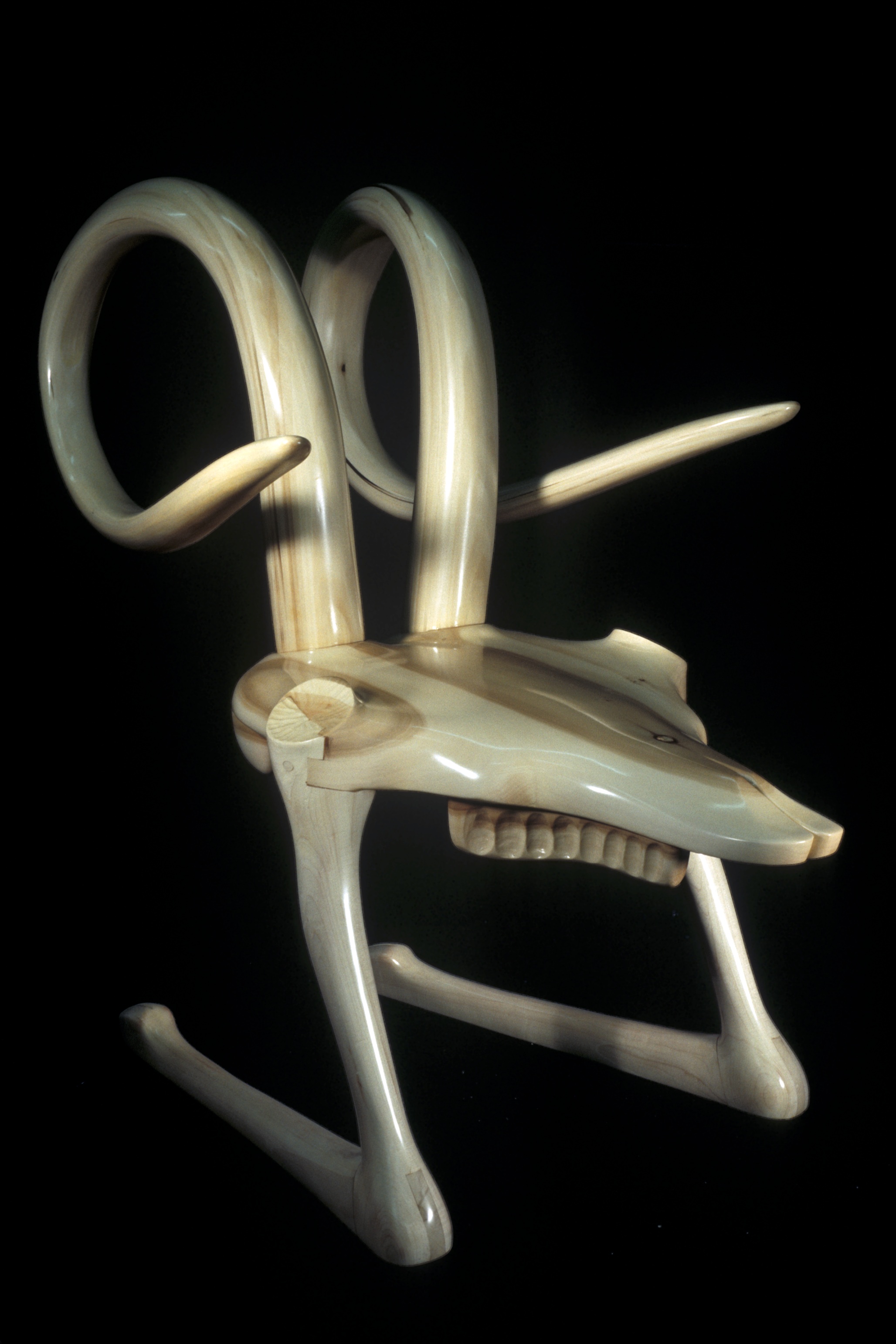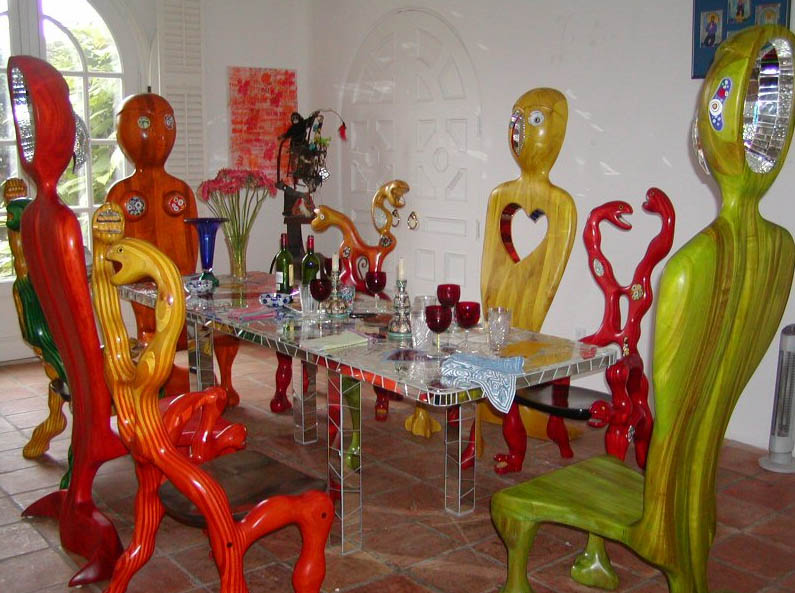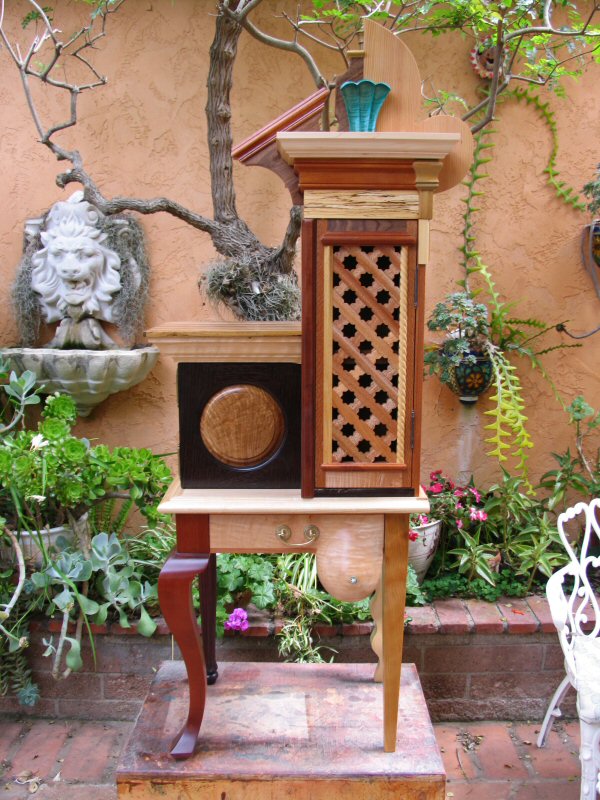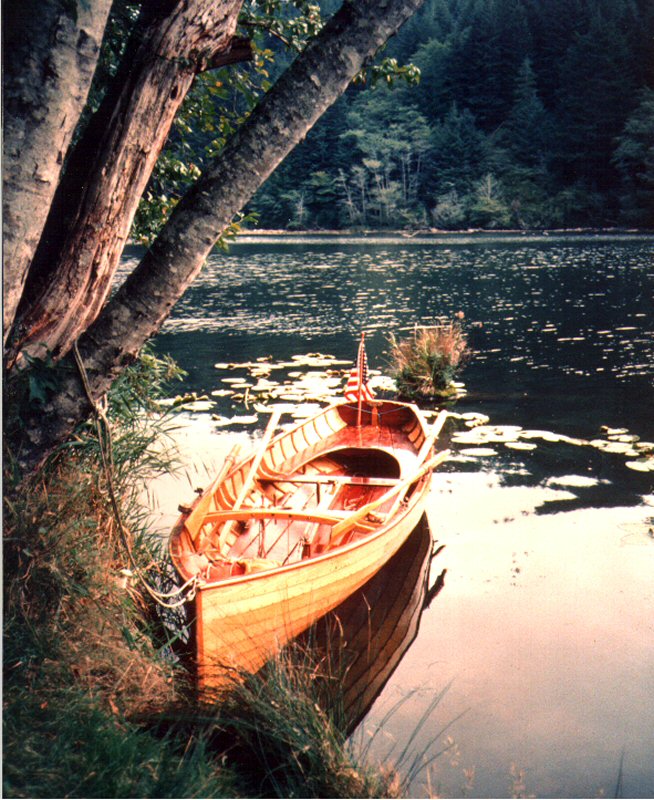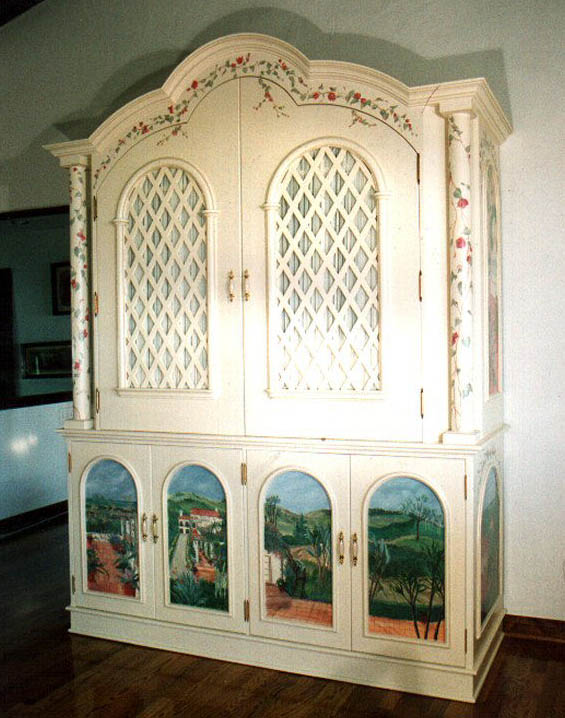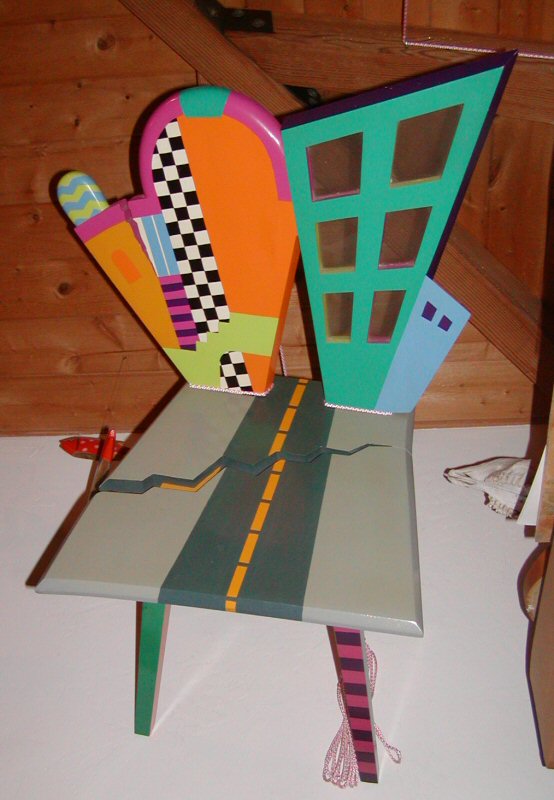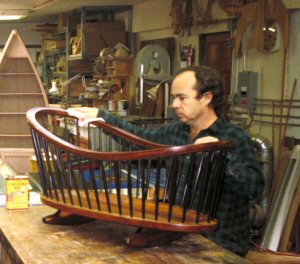
It’s hard to say whether Del Cover’s exquisite woodwork is furniture, art, or simply the fallout of an overly fertile imagination. Granted, some of his pieces look like fairly normal tables, chairs and chests, but others look as if they stepped out of an illustrated fantasy book. There’s a dragon headed hammock stand shaped like a Viking boat, a chair that looks like a sun bleached ram’s skull, chests with breasts and even chairs that let you sit in the center of an entire Italian coastal town.
“Whimsy is a big thing with me,” Del admitted, “and a lot of my furniture tends toward the whimsical. I’ve always felt a desire to create stuff that is interesting, fun, playful and has not been done before. I like visual puns, and plays on words show up in many of my pieces. For example, one early piece, called ‘A breast of drawers,’ is a dresser whose upper drawers are carved in the shape of breasts.
“Often I’ll do chairs using architectural elements. A trip to Italy during my honeymoon in 1987 inspired an interest in the architecture and beauty of the Italian hillside. One town, abandoned some 30 years ago after an earthquake, was the inspiration for The Postignano Chair. It showcases that town’s central courtyard as the seat, with the ruins surrounding it. A similar chair, called Riomaggorio, apes an Italian coastal hill town complete with sea wall.
“Earthquakes are a big issue down here in California where I work, so I have done several pieces that involve disasters. The Quaker Shaker 5.6 chair, done in collaboration with Vickie Cytherd, is a good example. It’s a fully functional chair that evokes elements of a city during an earthquake.
“New York City Park Bench, done after 9/11, reminds one of the view of the buildings surrounding Central Park. To commemorate the events of 9/11, the side struts mimic the few pieces of the Trade Center skeleton initially left standing.”
While many of his pieces are spawned by his own desires to make something interesting and unusual, some are instigated by customers. “One rather eccentric client asked me to design him a hammock stand,” Del recounted. “I came up with three designs. My favorite was Cleopatra’s barge, but he picked the dragon boat. Eventually, the piece made the back cover of a prestigious woodworking magazine. Another chair I call ‘The Original Southwest Chair’ pays homage to a stylized skull of a bighorn sheep.
“In 1994 I got a call from artist Nikki de St. Phalle to build some tables for her studio. She saw some of my artwork and asked if I wanted to make some of her designs. She had worked in polyester, paper, stone and tile, but never in wood. One of the first groupings I did for her included the snake chairs, the first batch of which was donated to a museum in Basal, Switzerland. Over the next seven years I built over 120 pieces for her, many of them chairs. They reside all over the world both in private collections and in museums. About three years ago, not long after her death, one of the chairs went for close to $40,000 at auction, and they have gone up since then.”
Don’t think that it is simply whimsy that sets Del’s work apart. There’s also superb craftsmanship. As I count Del among my friends, I have been lucky enough to see his work first hand, and I can assure you that the closer you get, the better it looks. I’m not the only one who has noticed. His awards for excellence include first place for craftsmanship at the Newport Wooden Boat Show and first place in almost every award category at the Del Mar Fair “Design in Wood Show,” including Traditional furniture, Contemporary furniture, Art furniture, Model building, Made for children, Sponsor’s trophy, Superintendent’s Trophy and the San Diego Fine Woodworking Professional woodworking award.
Del has been exhibiting at the Design in Wood show since its inception a quarter century ago. “To commemorate the 25th anniversary of the show,” he told me, “I built a piece that is a compilation of many of my previous pieces incorporating elements of former pieces. I named it ‘Best of Show,’ but one of the show organizers didn’t like that, so I renamed it ‘One piece at a time’ for the duration of the show.”
Del’s fascination with wood started not with furniture, but with boats. “I took woodshop classes in junior high, making the typical stuff. Then in eighth grade I was part of a program in school to build an 18 inch model boat, then race it in a regatta. I won an award for the construction, then went on to win the race. After college I built some furniture and learned to finish it from an uncle who managed a coffin factory. I did once build a coffin, but I later converted it into a sailboat and named it, appropriately enough, ‘Styx.’
“After graduating college with a degree in chemistry, I took a job as an analytical chemist in an electroplating shop. On several occasions we remodeled the labs, and that gave me a chance to do more furniture building. I then took a job with Scripps Institution of Oceanography as a marine lab technician. While there I got interested in boats again and at one point made an admiral’s model. That’s an exposed model built from the keel up with the hull peeled back and all the proper structure showing.
“I realized that in the time it took to build a model I could have made a real boat, so I did. My first boat was an 18 foot all wood cruising sailboat. I sailed it for about two years, then sold it to buy my house. I built a couple of other traditional boats, restored a classic sailboat, and built an off shore racing sailboat.
“At some point I decided I wanted to learn to make furniture and started to teach myself. I set up a shop at my home and proceeded to build furniture for the next ten years. Some I kept, and some I sold, but when my job at Scripps ended in 1986, my hobby became my day job. Over the years my pieces ranged from simple Windsor and modern slab styles to intricate Moorish influences, inlaid tables and painted panels.
“Boats did not go away entirely, though. America’s Cup racers used to build one third scale, highly accurate tow tank models to test out their designs. They were typically about 22 feet long and were floated in a tank to check the flow around the hull. In 1987, a friend who owned a boat building company approached me to help him build one of these models for the American team, which later went on to win that year.
“I feel blessed that I have been able to do this,” Del confessed when I asked him how he feels about his chosen profession. “This is not a nine to five job, but the fact that my shop is here at my house means I got to see my kids constantly growing up, and they came to understand what I do.
“One day when my oldest daughter was about four, she came out into the shop and saw the dragon boat hammock I was making. It was a pivotal moment for her. I could see in her eyes the recognition of ‘Oh, this is what my father does.’ It made me proud and pleased to have her make that connection.”
